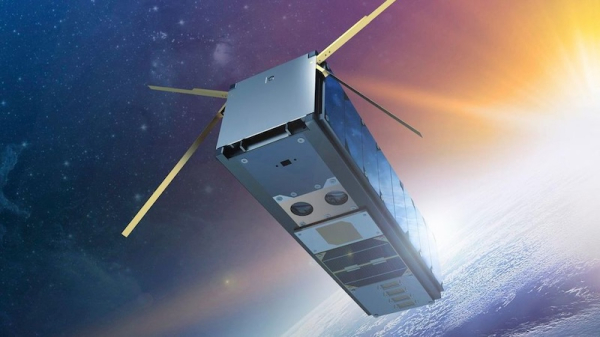
An illustration of the Aalto-1 satellite in space. Photo: Aalto-1 team
- Next Article New border procedure takes effect in Finland: streamlining asylum applications
Finland’s pioneering satellite, Aalto-1, is set to make its final pass over the country today, marking the end of a remarkable seven-year journey in space. The satellite, which was the first to be registered in Finland’s space registry, will re-enter Earth’s atmosphere and burn up, closing a chapter that began a new era in Finnish space exploration.
Launched on Midsummer’s Eve in 2017, Aalto-1 was a groundbreaking project led by students and researchers from Aalto University.
The satellite carried scientific instruments developed by the Finnish Meteorological Institute, the University of Turku, and VTT Technical Research Centre of Finland. This launch was a significant milestone, initiating Finland’s entry into the small satellite sector.
As Aalto-1 re-enters the atmosphere in early September, it will disintegrate due to friction, with most of it burning up completely. If this event occurs at night, the satellite’s descent could resemble a slow-moving, bright meteor streaking across the sky. Today’s pass over Finland is expected to be the satellite’s last.
Professor Jaan Praks, who led the project, reflects on the moment with mixed emotions. “It’s bittersweet, but I’m also happy that Aalto-1 is making way for a new generation of Finnish satellites instead of becoming space debris,” he says.
Aalto-1, roughly the size of a large milk carton and weighing four kilograms, made significant contributions to Finnish space history. It led to the creation of Finland’s space law and space object registry, and was the first Finnish space object listed in the international space registry. The satellite’s success spurred the development of a vibrant space industry in Finland, inspiring numerous commercial satellite projects.
“Today, Finland has dozens of satellites in space, almost all of them built in Otaniemi. Companies like ICEYE, Kuva Space, Arctic Astronautics, and Aurora Propulsion Systems owe their existence to this student project that brought together passionate future space engineers,” Praks proudly notes.
The momentum continues, with students at Aalto University still deeply involved in satellite development. Finland’s space sector is bustling, with Otaniemi producing up to ten satellites a year, mostly commercial radar satellites by ICEYE. Moreover, Finnish institutions are creating instruments for international space missions, with roots tracing back to the instruments aboard Aalto-1.
Aalto University is actively participating in major space science projects, including software development for the European Space Agency’s Comet Interceptor and HERA satellite missions. The university’s student satellite team is also gearing up for new projects, with the potential for two student-led satellites to launch next year.
Aalto-1 carried three scientific instruments into space: an imaging spectrometer developed by VTT, a radiation detector created in collaboration with the universities of Helsinki and Turku, and a plasma brake designed by the Finnish Meteorological Institute. The development of these instruments has continued, with advanced versions featured in new space missions, including asteroid imaging projects.
“Finland’s journey into space was built on collaboration,” Praks emphasizes. “We received support from various experts, research centers, and companies, often without dedicated funding. The Aalto project was primarily funded by Aalto University’s Multidisciplinary Institute of Digitalisation and Energy (MIDE), with additional launch support from Finnish companies and institutions. We owe them all a huge thank you.”
As Aalto-1 concludes its mission, Finland’s space ambitions continue to rise, propelled by the legacy of this pioneering satellite.
HT
- Next Article New border procedure takes effect in Finland: streamlining asylum applications
Source: www.helsinkitimes.fi
